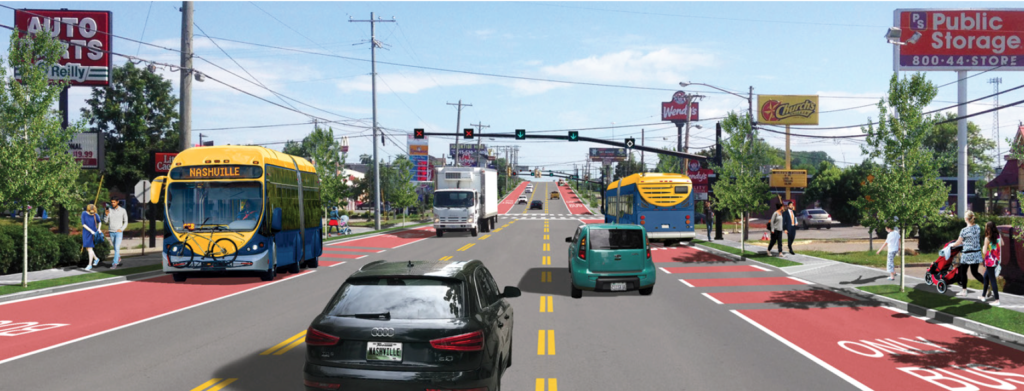
One of the lingering disagreements over Nashville’s transit proposal is how it would impact development along proposed light rail and rapid bus corridors — and if it would intensify the gentrification already happening.
It’s a subject that has caused a surprising rift between groups that might otherwise be allies in favor of the plan, as some affordable housing advocates have been unwilling to back transit out of the fear that low and middle-income residents may not experience the full benefit of improved service.
And it’s a question that was among the most common sent to WPLN in recent weeks:
What is being done in advance to insure homeowners are not displaced from the new transit routes? What guarantees are there for affordable housing be within walking distance of transit?
The fear for some is that development of frequent transit service along nine corridors will make those areas highly coveted, setting in motion a spike in land values and then higher-priced developments that could accelerate the pricing out of current residents.
From experience in other cities, this type of gentrification is likely — unless Metro takes steps to mitigate the effects.
A Well-Founded Fear
There has been some tangible action in recent weeks, as Metro hammers out the rules that would govern the city’s first “transit-oriented development district.” Metro Councilman Bob Mendes said this strategy — read below for details — is potentially Nashville’s “best chance” for adding affordable housing in the city.
But it would hinge on the passage of the referendum.
“Without the transit referendum, we’re still going to have upward pressure on real estate, but we won’t have these districts,” Mendes said. “With the transit referendum and the transit-oriented development that comes with it, we will have a tool to address affordability that should be valuable — and powerful — in trying to head off a deeper crisis.”
Yet for advocates like Austin Sauerbrei, who helps low-income renters defend their rights, the threat of gentrification remains a sticking point, with the proposed development districts “better than nothing,” but still short of what he would like to see.
“We know from empirical research, every time that there’s been a new light rail project in cities around the country, it has caused a skyrocketing land values,” he said. “If we don’t have very concrete anti-displacement policies in place … before we start building these light rails, it will spell mass displacement for folks along those corridors.”
Sauerbrei works with Homes For All Nashville, which is also part of the PATHE Coalition. That group has been officially agnostic on the transit proposal. But members have hounded city officials for months to beef up housing policies in concert with the transit plan, including through an
affordability task force that made non-binding recommendations, such as:
- setting targets for the number of affordable housing units to be added in each corridor
- acquire “land bank” property to be developed affordably
- preferential granting of permits to developers of affordable units
- creation of a funding source of more than $100 million for affordable housing and commercial space
Ultimately, the task force has not formally adopted such policies, which has attracted criticism.
“I’m really frightened about what it means to vote ‘yes’ without having any of those firm commitments up front,” Sauerbrei said.
Earlier this month, Mayor David Briley put out a video that appeared to speak to these concerns. In it, he pledges to create the desired dedicated funding source for housing, and the land bank.
Sauerbrei, though, remained unconvinced.
“We’ve been hearing very similar sentiment for the past decade,” he said. “We need to see some concrete progress … before we can truly believe the promise of an equitable city.”
But others saw that video differently — and found it compelling.
Transit As The Trigger
Councilman Mendes initially had deep questions about the transit proposal, and the potential that its benefits would not be felt equally. But recent
progress on transit-oriented development districts, coupled with the mayor’s pledges, now have him squarely in favor.
“I had been holding off on committing to that to see how the administration was going to handle affordable housing,” he said.
So what turned him?
Recent progress on transit-oriented development districts, the first of which will soon go to a public hearing at the Metro Council. Mendes has pushed for tweaks to the concept.
Here’s how it would work: Around transit stations, Metro could draw a special zone that adds rules about the types of development — such as a requirement that 10 percent of units meet affordability standards — plus bring in
tax-increment financing, or TIF, dollars to subsidize the construction of those units.
TIF districts anticipate that redevelopment of an area will bring in more property tax revenues in the future, which allows for a sizable up-front loan to be acquired to fund the redevelopment. It is then paid back when the future tax revenues come in. (See
a summary of TIF districts in Nashville.)
In these transit pockets, Nashville could see unprecedented concentrations of affordable housing funding.
In Donelson, for example, where a district is being created around a Music City Star train station, a pool of $10 million could be available to developers who make affordable units (and lock in their low prices for 30 years).
By comparison, the city’s Barnes Housing Trust Fund gave out $10 million last year — countywide.
“That’s bold. That’s a level of commitment to affordable housing through tax-increment financing that Nashville has never had before,” Mendes said.
Metro has not said how many of these districts would be created, and each one could vary in its terms, funding amounts and other rules.
The councilman said planning these districts could make Nashville different from other light rail cities that saw more gentrification.
“We’ve got an affordability crisis whether we’ve got transit or not,” Mendes said. “I think having the transit plan gives us more tools to try to maintain mixed income neighborhoods throughout the city.”


